University Leadership and Management Assignment 3: Challenges Today
VerifiedAdded on 2022/09/08
|11
|2462
|20
Report
AI Summary
This report, titled 'Leadership and Management – Assignment 3,' examines the evolving landscape of leadership in the contemporary world. It begins by defining leadership and highlighting its fundamental role in guiding teams and making critical decisions. The report then delves into the significant challenges leaders face today, including increased expectations, complex skill requirements, and heightened pressure from organizations and governments. It emphasizes the need for leaders to possess strong communication, market analysis, and strategic decision-making skills, along with the ability to manage diverse stakeholders. The report further explores the challenges of leadership in complex situations, emphasizing the importance of problem-solving, resource utilization, and continuous skill development. It concludes by offering recommendations for improving the quality of leadership development programs, focusing on key attributes such as coaching ability, accountability, change management, influence and negotiation, and communication. The report underscores the demanding nature of leadership and the importance of adapting to the ever-changing demands of the modern world.
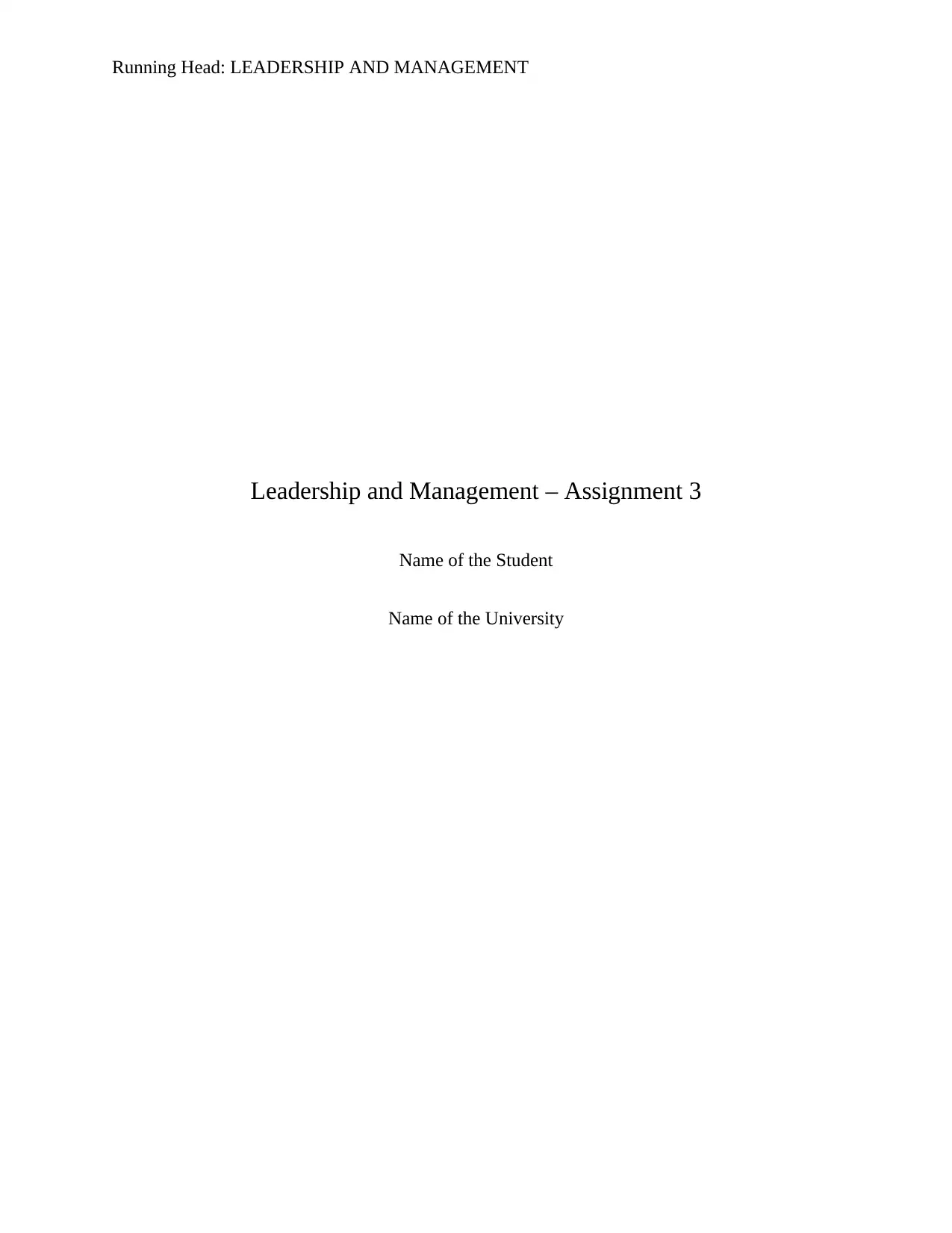
Running Head: LEADERSHIP AND MANAGEMENT
Leadership and Management – Assignment 3
Name of the Student
Name of the University
Leadership and Management – Assignment 3
Name of the Student
Name of the University
Paraphrase This Document
Need a fresh take? Get an instant paraphrase of this document with our AI Paraphraser
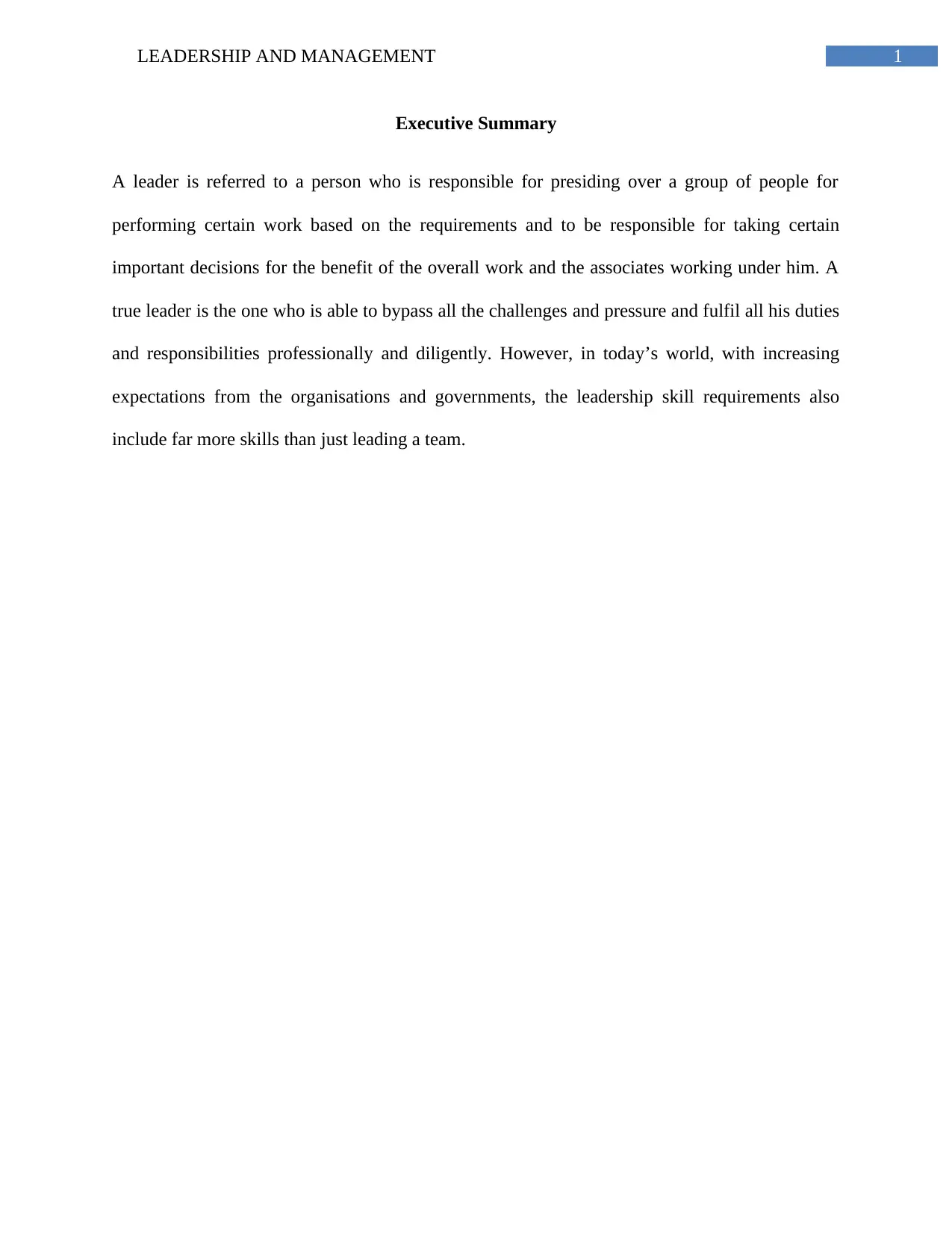
1LEADERSHIP AND MANAGEMENT
Executive Summary
A leader is referred to a person who is responsible for presiding over a group of people for
performing certain work based on the requirements and to be responsible for taking certain
important decisions for the benefit of the overall work and the associates working under him. A
true leader is the one who is able to bypass all the challenges and pressure and fulfil all his duties
and responsibilities professionally and diligently. However, in today’s world, with increasing
expectations from the organisations and governments, the leadership skill requirements also
include far more skills than just leading a team.
Executive Summary
A leader is referred to a person who is responsible for presiding over a group of people for
performing certain work based on the requirements and to be responsible for taking certain
important decisions for the benefit of the overall work and the associates working under him. A
true leader is the one who is able to bypass all the challenges and pressure and fulfil all his duties
and responsibilities professionally and diligently. However, in today’s world, with increasing
expectations from the organisations and governments, the leadership skill requirements also
include far more skills than just leading a team.
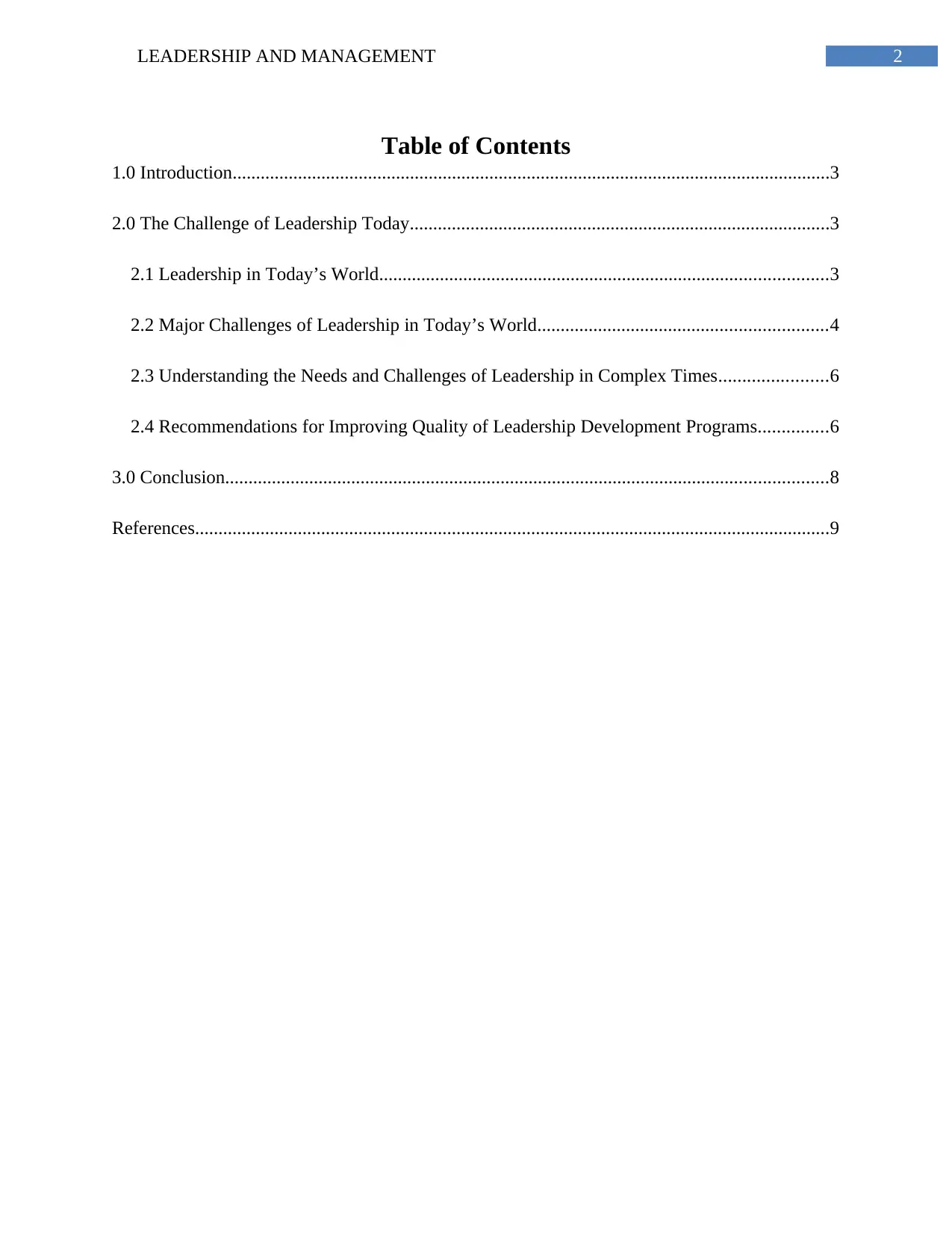
2LEADERSHIP AND MANAGEMENT
Table of Contents
1.0 Introduction................................................................................................................................3
2.0 The Challenge of Leadership Today..........................................................................................3
2.1 Leadership in Today’s World................................................................................................3
2.2 Major Challenges of Leadership in Today’s World..............................................................4
2.3 Understanding the Needs and Challenges of Leadership in Complex Times.......................6
2.4 Recommendations for Improving Quality of Leadership Development Programs...............6
3.0 Conclusion.................................................................................................................................8
References........................................................................................................................................9
Table of Contents
1.0 Introduction................................................................................................................................3
2.0 The Challenge of Leadership Today..........................................................................................3
2.1 Leadership in Today’s World................................................................................................3
2.2 Major Challenges of Leadership in Today’s World..............................................................4
2.3 Understanding the Needs and Challenges of Leadership in Complex Times.......................6
2.4 Recommendations for Improving Quality of Leadership Development Programs...............6
3.0 Conclusion.................................................................................................................................8
References........................................................................................................................................9
⊘ This is a preview!⊘
Do you want full access?
Subscribe today to unlock all pages.

Trusted by 1+ million students worldwide
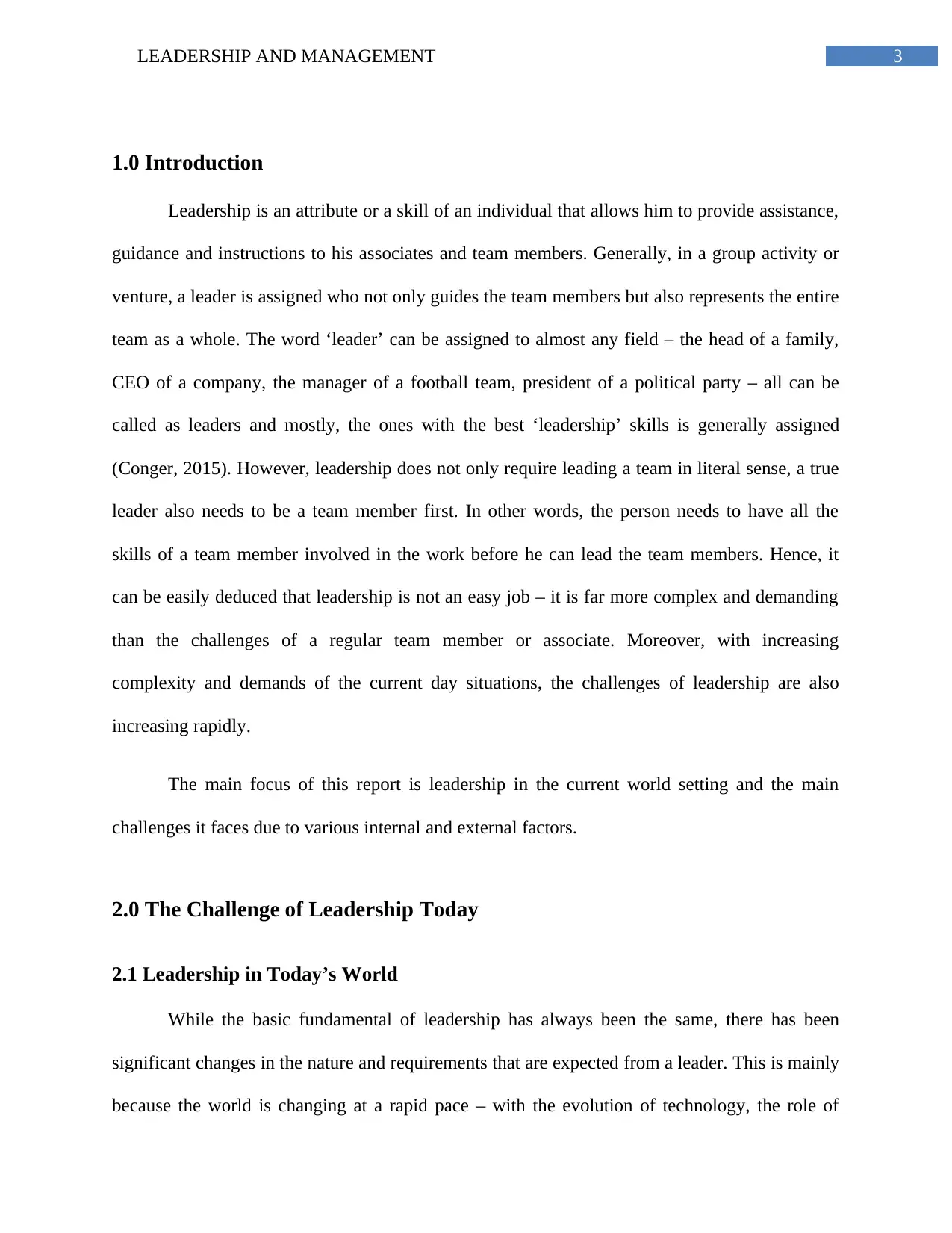
3LEADERSHIP AND MANAGEMENT
1.0 Introduction
Leadership is an attribute or a skill of an individual that allows him to provide assistance,
guidance and instructions to his associates and team members. Generally, in a group activity or
venture, a leader is assigned who not only guides the team members but also represents the entire
team as a whole. The word ‘leader’ can be assigned to almost any field – the head of a family,
CEO of a company, the manager of a football team, president of a political party – all can be
called as leaders and mostly, the ones with the best ‘leadership’ skills is generally assigned
(Conger, 2015). However, leadership does not only require leading a team in literal sense, a true
leader also needs to be a team member first. In other words, the person needs to have all the
skills of a team member involved in the work before he can lead the team members. Hence, it
can be easily deduced that leadership is not an easy job – it is far more complex and demanding
than the challenges of a regular team member or associate. Moreover, with increasing
complexity and demands of the current day situations, the challenges of leadership are also
increasing rapidly.
The main focus of this report is leadership in the current world setting and the main
challenges it faces due to various internal and external factors.
2.0 The Challenge of Leadership Today
2.1 Leadership in Today’s World
While the basic fundamental of leadership has always been the same, there has been
significant changes in the nature and requirements that are expected from a leader. This is mainly
because the world is changing at a rapid pace – with the evolution of technology, the role of
1.0 Introduction
Leadership is an attribute or a skill of an individual that allows him to provide assistance,
guidance and instructions to his associates and team members. Generally, in a group activity or
venture, a leader is assigned who not only guides the team members but also represents the entire
team as a whole. The word ‘leader’ can be assigned to almost any field – the head of a family,
CEO of a company, the manager of a football team, president of a political party – all can be
called as leaders and mostly, the ones with the best ‘leadership’ skills is generally assigned
(Conger, 2015). However, leadership does not only require leading a team in literal sense, a true
leader also needs to be a team member first. In other words, the person needs to have all the
skills of a team member involved in the work before he can lead the team members. Hence, it
can be easily deduced that leadership is not an easy job – it is far more complex and demanding
than the challenges of a regular team member or associate. Moreover, with increasing
complexity and demands of the current day situations, the challenges of leadership are also
increasing rapidly.
The main focus of this report is leadership in the current world setting and the main
challenges it faces due to various internal and external factors.
2.0 The Challenge of Leadership Today
2.1 Leadership in Today’s World
While the basic fundamental of leadership has always been the same, there has been
significant changes in the nature and requirements that are expected from a leader. This is mainly
because the world is changing at a rapid pace – with the evolution of technology, the role of
Paraphrase This Document
Need a fresh take? Get an instant paraphrase of this document with our AI Paraphraser
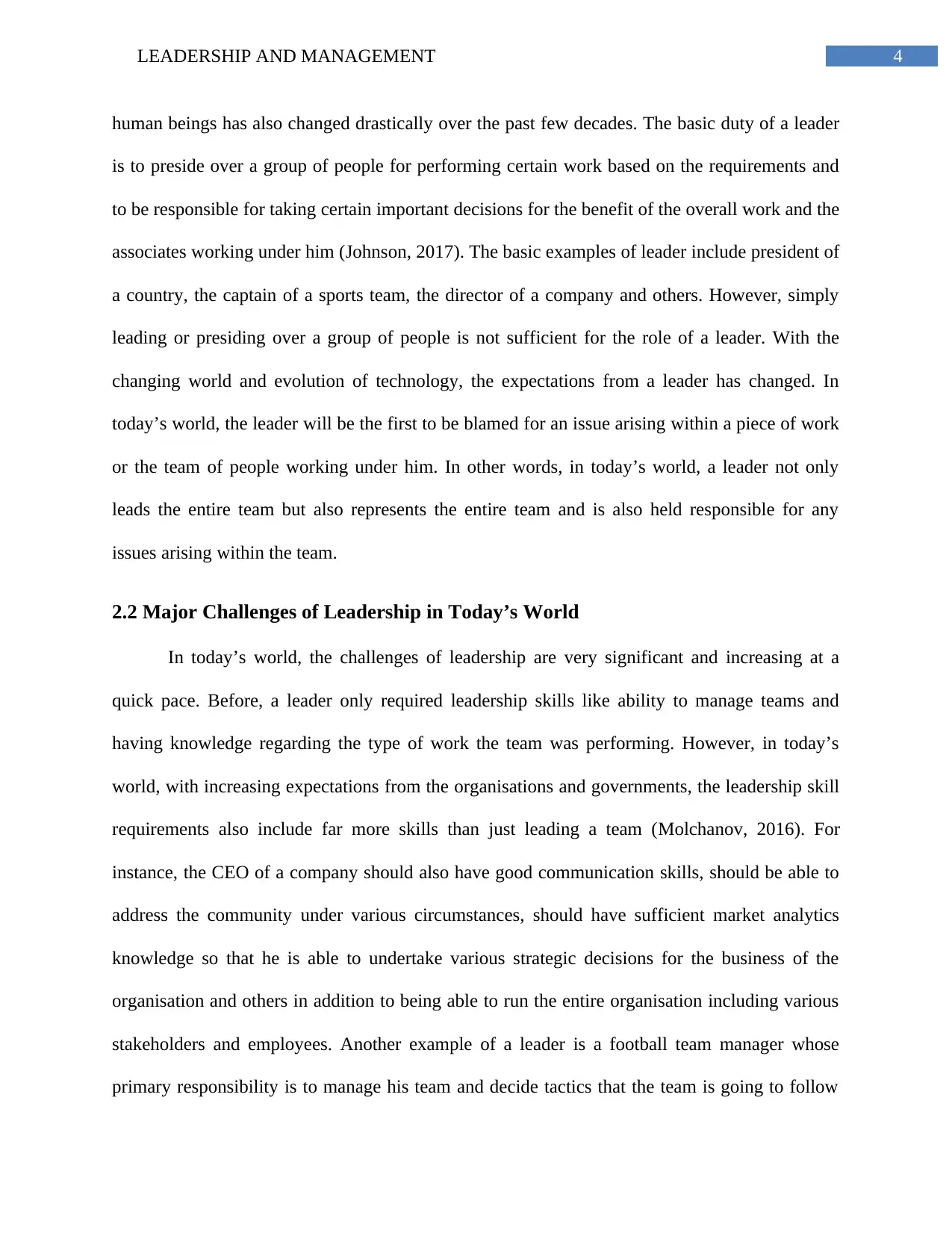
4LEADERSHIP AND MANAGEMENT
human beings has also changed drastically over the past few decades. The basic duty of a leader
is to preside over a group of people for performing certain work based on the requirements and
to be responsible for taking certain important decisions for the benefit of the overall work and the
associates working under him (Johnson, 2017). The basic examples of leader include president of
a country, the captain of a sports team, the director of a company and others. However, simply
leading or presiding over a group of people is not sufficient for the role of a leader. With the
changing world and evolution of technology, the expectations from a leader has changed. In
today’s world, the leader will be the first to be blamed for an issue arising within a piece of work
or the team of people working under him. In other words, in today’s world, a leader not only
leads the entire team but also represents the entire team and is also held responsible for any
issues arising within the team.
2.2 Major Challenges of Leadership in Today’s World
In today’s world, the challenges of leadership are very significant and increasing at a
quick pace. Before, a leader only required leadership skills like ability to manage teams and
having knowledge regarding the type of work the team was performing. However, in today’s
world, with increasing expectations from the organisations and governments, the leadership skill
requirements also include far more skills than just leading a team (Molchanov, 2016). For
instance, the CEO of a company should also have good communication skills, should be able to
address the community under various circumstances, should have sufficient market analytics
knowledge so that he is able to undertake various strategic decisions for the business of the
organisation and others in addition to being able to run the entire organisation including various
stakeholders and employees. Another example of a leader is a football team manager whose
primary responsibility is to manage his team and decide tactics that the team is going to follow
human beings has also changed drastically over the past few decades. The basic duty of a leader
is to preside over a group of people for performing certain work based on the requirements and
to be responsible for taking certain important decisions for the benefit of the overall work and the
associates working under him (Johnson, 2017). The basic examples of leader include president of
a country, the captain of a sports team, the director of a company and others. However, simply
leading or presiding over a group of people is not sufficient for the role of a leader. With the
changing world and evolution of technology, the expectations from a leader has changed. In
today’s world, the leader will be the first to be blamed for an issue arising within a piece of work
or the team of people working under him. In other words, in today’s world, a leader not only
leads the entire team but also represents the entire team and is also held responsible for any
issues arising within the team.
2.2 Major Challenges of Leadership in Today’s World
In today’s world, the challenges of leadership are very significant and increasing at a
quick pace. Before, a leader only required leadership skills like ability to manage teams and
having knowledge regarding the type of work the team was performing. However, in today’s
world, with increasing expectations from the organisations and governments, the leadership skill
requirements also include far more skills than just leading a team (Molchanov, 2016). For
instance, the CEO of a company should also have good communication skills, should be able to
address the community under various circumstances, should have sufficient market analytics
knowledge so that he is able to undertake various strategic decisions for the business of the
organisation and others in addition to being able to run the entire organisation including various
stakeholders and employees. Another example of a leader is a football team manager whose
primary responsibility is to manage his team and decide tactics that the team is going to follow
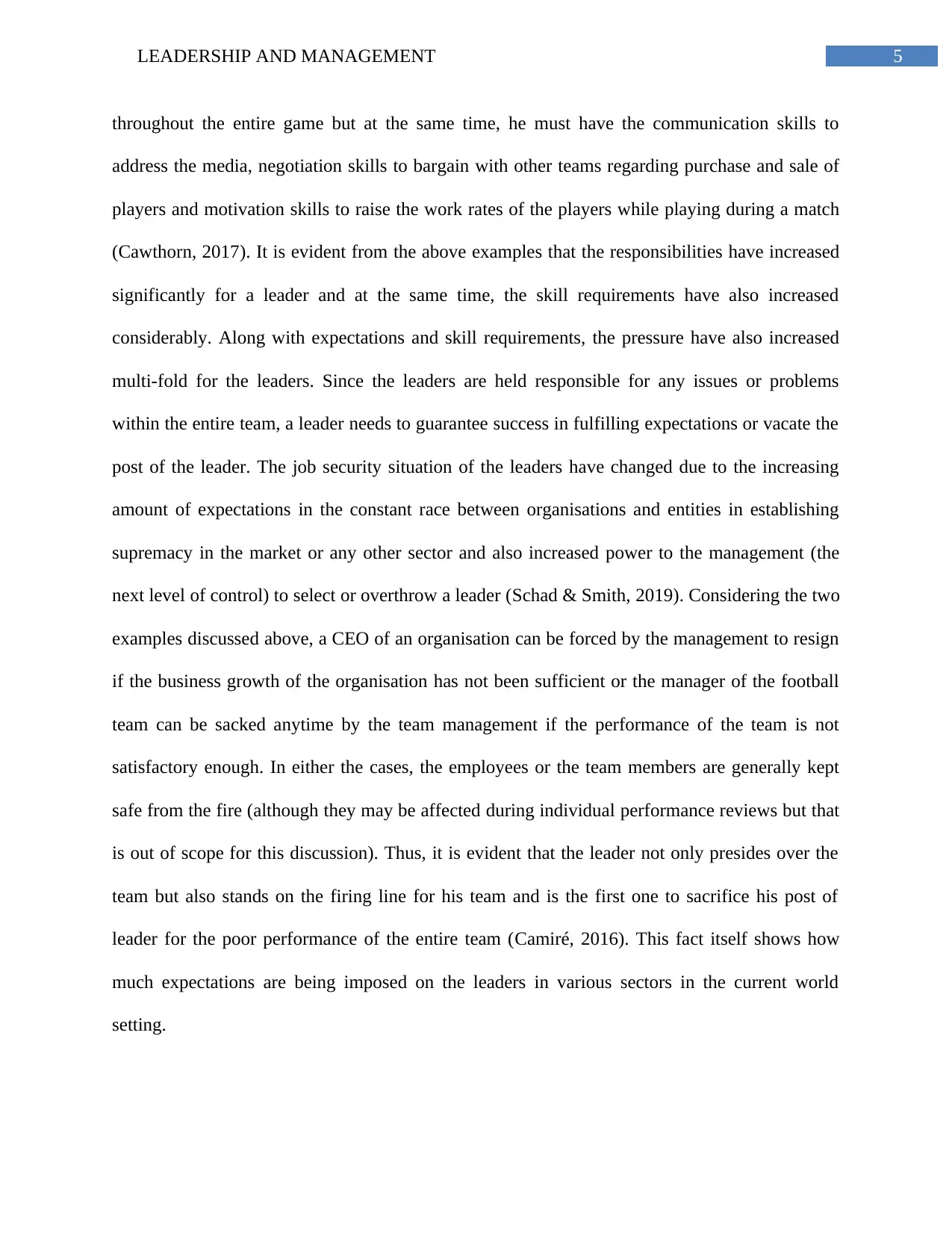
5LEADERSHIP AND MANAGEMENT
throughout the entire game but at the same time, he must have the communication skills to
address the media, negotiation skills to bargain with other teams regarding purchase and sale of
players and motivation skills to raise the work rates of the players while playing during a match
(Cawthorn, 2017). It is evident from the above examples that the responsibilities have increased
significantly for a leader and at the same time, the skill requirements have also increased
considerably. Along with expectations and skill requirements, the pressure have also increased
multi-fold for the leaders. Since the leaders are held responsible for any issues or problems
within the entire team, a leader needs to guarantee success in fulfilling expectations or vacate the
post of the leader. The job security situation of the leaders have changed due to the increasing
amount of expectations in the constant race between organisations and entities in establishing
supremacy in the market or any other sector and also increased power to the management (the
next level of control) to select or overthrow a leader (Schad & Smith, 2019). Considering the two
examples discussed above, a CEO of an organisation can be forced by the management to resign
if the business growth of the organisation has not been sufficient or the manager of the football
team can be sacked anytime by the team management if the performance of the team is not
satisfactory enough. In either the cases, the employees or the team members are generally kept
safe from the fire (although they may be affected during individual performance reviews but that
is out of scope for this discussion). Thus, it is evident that the leader not only presides over the
team but also stands on the firing line for his team and is the first one to sacrifice his post of
leader for the poor performance of the entire team (Camiré, 2016). This fact itself shows how
much expectations are being imposed on the leaders in various sectors in the current world
setting.
throughout the entire game but at the same time, he must have the communication skills to
address the media, negotiation skills to bargain with other teams regarding purchase and sale of
players and motivation skills to raise the work rates of the players while playing during a match
(Cawthorn, 2017). It is evident from the above examples that the responsibilities have increased
significantly for a leader and at the same time, the skill requirements have also increased
considerably. Along with expectations and skill requirements, the pressure have also increased
multi-fold for the leaders. Since the leaders are held responsible for any issues or problems
within the entire team, a leader needs to guarantee success in fulfilling expectations or vacate the
post of the leader. The job security situation of the leaders have changed due to the increasing
amount of expectations in the constant race between organisations and entities in establishing
supremacy in the market or any other sector and also increased power to the management (the
next level of control) to select or overthrow a leader (Schad & Smith, 2019). Considering the two
examples discussed above, a CEO of an organisation can be forced by the management to resign
if the business growth of the organisation has not been sufficient or the manager of the football
team can be sacked anytime by the team management if the performance of the team is not
satisfactory enough. In either the cases, the employees or the team members are generally kept
safe from the fire (although they may be affected during individual performance reviews but that
is out of scope for this discussion). Thus, it is evident that the leader not only presides over the
team but also stands on the firing line for his team and is the first one to sacrifice his post of
leader for the poor performance of the entire team (Camiré, 2016). This fact itself shows how
much expectations are being imposed on the leaders in various sectors in the current world
setting.
⊘ This is a preview!⊘
Do you want full access?
Subscribe today to unlock all pages.

Trusted by 1+ million students worldwide
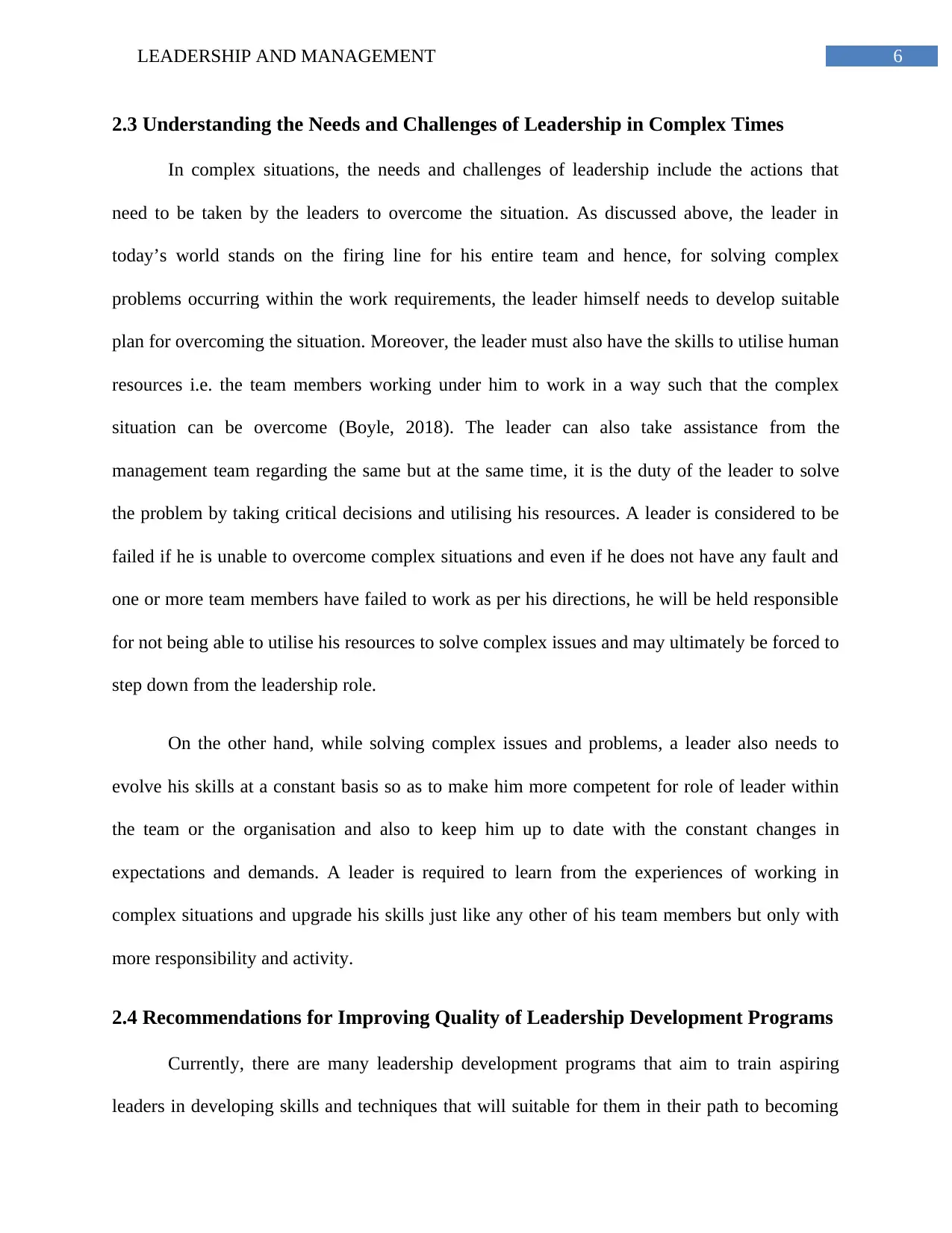
6LEADERSHIP AND MANAGEMENT
2.3 Understanding the Needs and Challenges of Leadership in Complex Times
In complex situations, the needs and challenges of leadership include the actions that
need to be taken by the leaders to overcome the situation. As discussed above, the leader in
today’s world stands on the firing line for his entire team and hence, for solving complex
problems occurring within the work requirements, the leader himself needs to develop suitable
plan for overcoming the situation. Moreover, the leader must also have the skills to utilise human
resources i.e. the team members working under him to work in a way such that the complex
situation can be overcome (Boyle, 2018). The leader can also take assistance from the
management team regarding the same but at the same time, it is the duty of the leader to solve
the problem by taking critical decisions and utilising his resources. A leader is considered to be
failed if he is unable to overcome complex situations and even if he does not have any fault and
one or more team members have failed to work as per his directions, he will be held responsible
for not being able to utilise his resources to solve complex issues and may ultimately be forced to
step down from the leadership role.
On the other hand, while solving complex issues and problems, a leader also needs to
evolve his skills at a constant basis so as to make him more competent for role of leader within
the team or the organisation and also to keep him up to date with the constant changes in
expectations and demands. A leader is required to learn from the experiences of working in
complex situations and upgrade his skills just like any other of his team members but only with
more responsibility and activity.
2.4 Recommendations for Improving Quality of Leadership Development Programs
Currently, there are many leadership development programs that aim to train aspiring
leaders in developing skills and techniques that will suitable for them in their path to becoming
2.3 Understanding the Needs and Challenges of Leadership in Complex Times
In complex situations, the needs and challenges of leadership include the actions that
need to be taken by the leaders to overcome the situation. As discussed above, the leader in
today’s world stands on the firing line for his entire team and hence, for solving complex
problems occurring within the work requirements, the leader himself needs to develop suitable
plan for overcoming the situation. Moreover, the leader must also have the skills to utilise human
resources i.e. the team members working under him to work in a way such that the complex
situation can be overcome (Boyle, 2018). The leader can also take assistance from the
management team regarding the same but at the same time, it is the duty of the leader to solve
the problem by taking critical decisions and utilising his resources. A leader is considered to be
failed if he is unable to overcome complex situations and even if he does not have any fault and
one or more team members have failed to work as per his directions, he will be held responsible
for not being able to utilise his resources to solve complex issues and may ultimately be forced to
step down from the leadership role.
On the other hand, while solving complex issues and problems, a leader also needs to
evolve his skills at a constant basis so as to make him more competent for role of leader within
the team or the organisation and also to keep him up to date with the constant changes in
expectations and demands. A leader is required to learn from the experiences of working in
complex situations and upgrade his skills just like any other of his team members but only with
more responsibility and activity.
2.4 Recommendations for Improving Quality of Leadership Development Programs
Currently, there are many leadership development programs that aim to train aspiring
leaders in developing skills and techniques that will suitable for them in their path to becoming
Paraphrase This Document
Need a fresh take? Get an instant paraphrase of this document with our AI Paraphraser
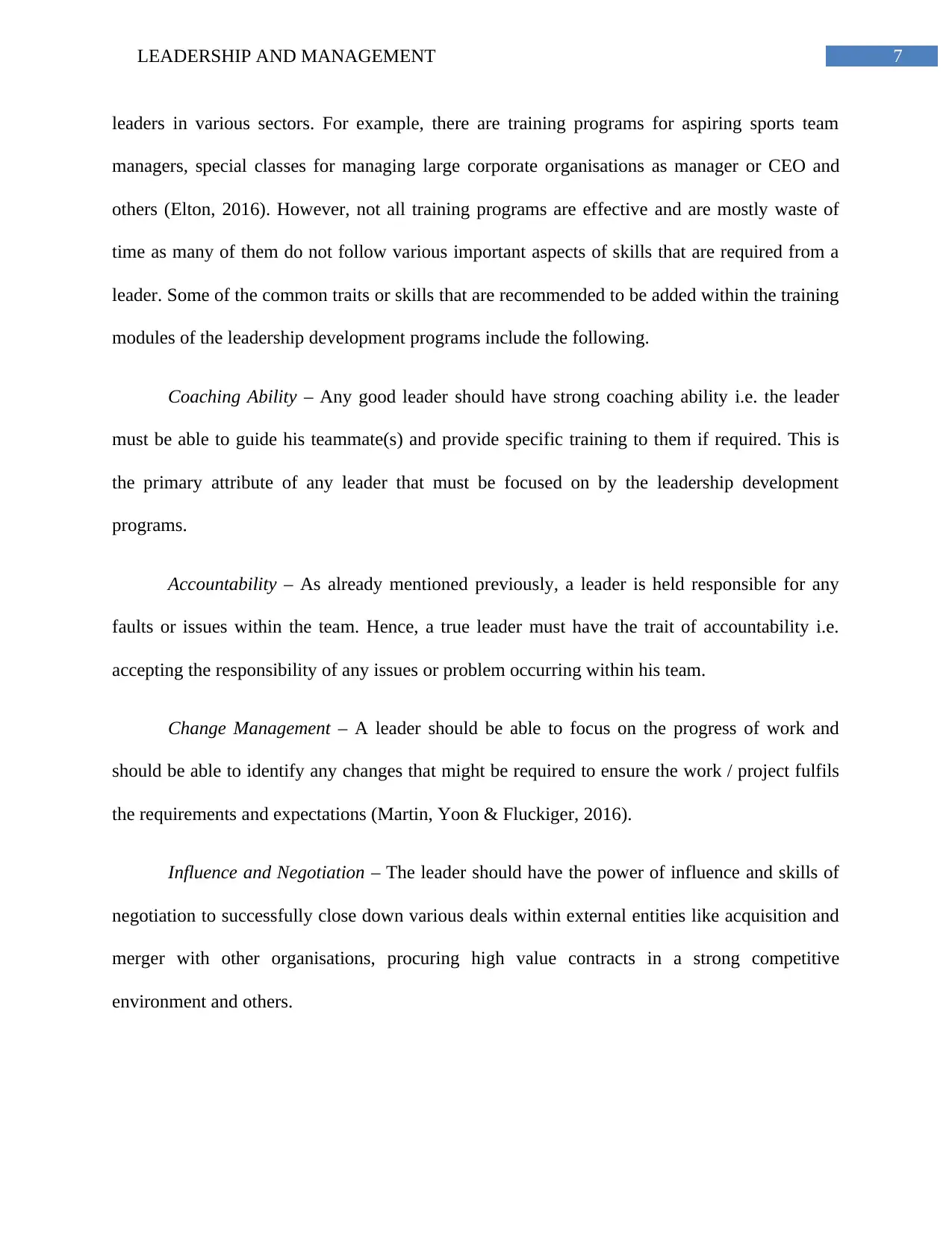
7LEADERSHIP AND MANAGEMENT
leaders in various sectors. For example, there are training programs for aspiring sports team
managers, special classes for managing large corporate organisations as manager or CEO and
others (Elton, 2016). However, not all training programs are effective and are mostly waste of
time as many of them do not follow various important aspects of skills that are required from a
leader. Some of the common traits or skills that are recommended to be added within the training
modules of the leadership development programs include the following.
Coaching Ability – Any good leader should have strong coaching ability i.e. the leader
must be able to guide his teammate(s) and provide specific training to them if required. This is
the primary attribute of any leader that must be focused on by the leadership development
programs.
Accountability – As already mentioned previously, a leader is held responsible for any
faults or issues within the team. Hence, a true leader must have the trait of accountability i.e.
accepting the responsibility of any issues or problem occurring within his team.
Change Management – A leader should be able to focus on the progress of work and
should be able to identify any changes that might be required to ensure the work / project fulfils
the requirements and expectations (Martin, Yoon & Fluckiger, 2016).
Influence and Negotiation – The leader should have the power of influence and skills of
negotiation to successfully close down various deals within external entities like acquisition and
merger with other organisations, procuring high value contracts in a strong competitive
environment and others.
leaders in various sectors. For example, there are training programs for aspiring sports team
managers, special classes for managing large corporate organisations as manager or CEO and
others (Elton, 2016). However, not all training programs are effective and are mostly waste of
time as many of them do not follow various important aspects of skills that are required from a
leader. Some of the common traits or skills that are recommended to be added within the training
modules of the leadership development programs include the following.
Coaching Ability – Any good leader should have strong coaching ability i.e. the leader
must be able to guide his teammate(s) and provide specific training to them if required. This is
the primary attribute of any leader that must be focused on by the leadership development
programs.
Accountability – As already mentioned previously, a leader is held responsible for any
faults or issues within the team. Hence, a true leader must have the trait of accountability i.e.
accepting the responsibility of any issues or problem occurring within his team.
Change Management – A leader should be able to focus on the progress of work and
should be able to identify any changes that might be required to ensure the work / project fulfils
the requirements and expectations (Martin, Yoon & Fluckiger, 2016).
Influence and Negotiation – The leader should have the power of influence and skills of
negotiation to successfully close down various deals within external entities like acquisition and
merger with other organisations, procuring high value contracts in a strong competitive
environment and others.
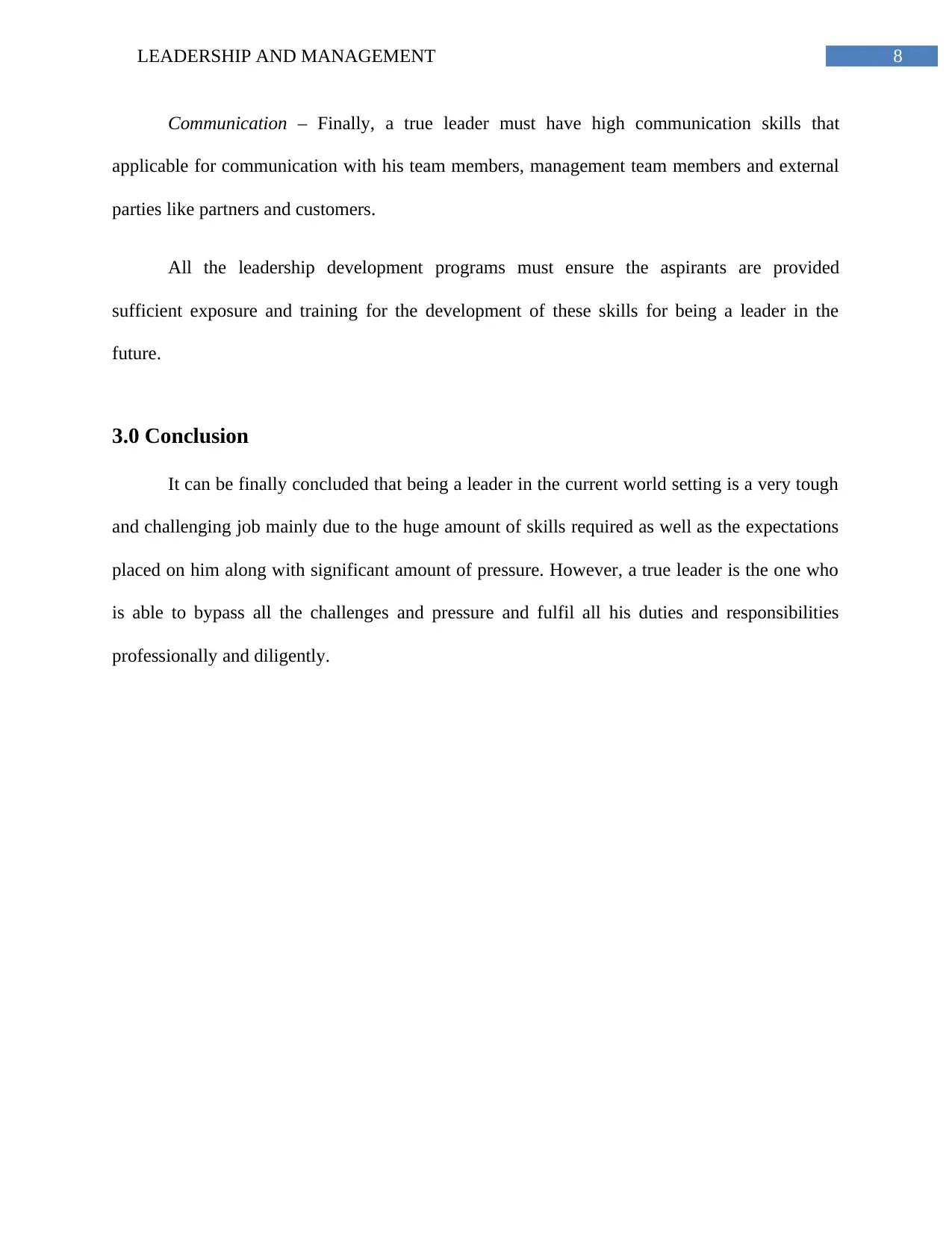
8LEADERSHIP AND MANAGEMENT
Communication – Finally, a true leader must have high communication skills that
applicable for communication with his team members, management team members and external
parties like partners and customers.
All the leadership development programs must ensure the aspirants are provided
sufficient exposure and training for the development of these skills for being a leader in the
future.
3.0 Conclusion
It can be finally concluded that being a leader in the current world setting is a very tough
and challenging job mainly due to the huge amount of skills required as well as the expectations
placed on him along with significant amount of pressure. However, a true leader is the one who
is able to bypass all the challenges and pressure and fulfil all his duties and responsibilities
professionally and diligently.
Communication – Finally, a true leader must have high communication skills that
applicable for communication with his team members, management team members and external
parties like partners and customers.
All the leadership development programs must ensure the aspirants are provided
sufficient exposure and training for the development of these skills for being a leader in the
future.
3.0 Conclusion
It can be finally concluded that being a leader in the current world setting is a very tough
and challenging job mainly due to the huge amount of skills required as well as the expectations
placed on him along with significant amount of pressure. However, a true leader is the one who
is able to bypass all the challenges and pressure and fulfil all his duties and responsibilities
professionally and diligently.
⊘ This is a preview!⊘
Do you want full access?
Subscribe today to unlock all pages.

Trusted by 1+ million students worldwide
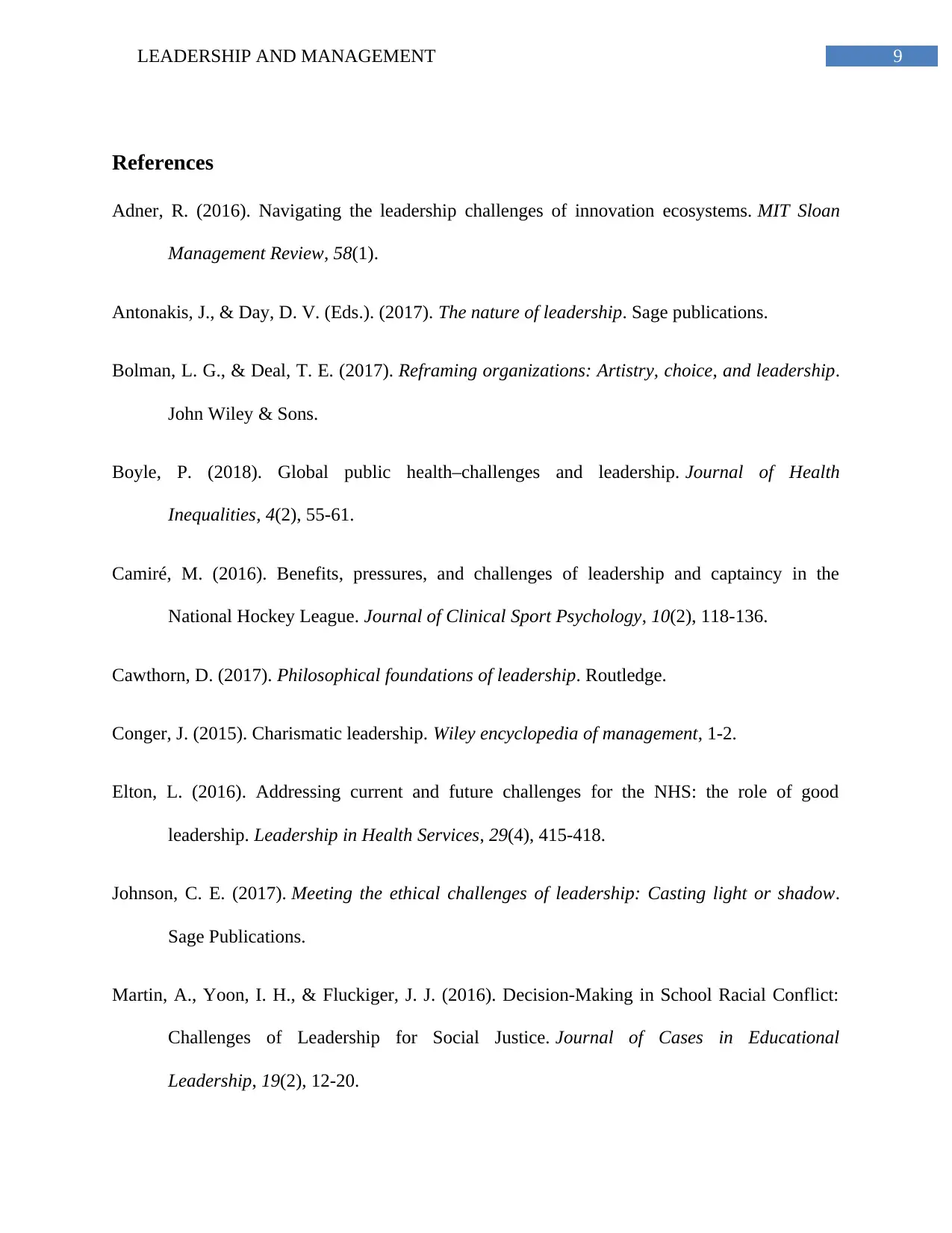
9LEADERSHIP AND MANAGEMENT
References
Adner, R. (2016). Navigating the leadership challenges of innovation ecosystems. MIT Sloan
Management Review, 58(1).
Antonakis, J., & Day, D. V. (Eds.). (2017). The nature of leadership. Sage publications.
Bolman, L. G., & Deal, T. E. (2017). Reframing organizations: Artistry, choice, and leadership.
John Wiley & Sons.
Boyle, P. (2018). Global public health–challenges and leadership. Journal of Health
Inequalities, 4(2), 55-61.
Camiré, M. (2016). Benefits, pressures, and challenges of leadership and captaincy in the
National Hockey League. Journal of Clinical Sport Psychology, 10(2), 118-136.
Cawthorn, D. (2017). Philosophical foundations of leadership. Routledge.
Conger, J. (2015). Charismatic leadership. Wiley encyclopedia of management, 1-2.
Elton, L. (2016). Addressing current and future challenges for the NHS: the role of good
leadership. Leadership in Health Services, 29(4), 415-418.
Johnson, C. E. (2017). Meeting the ethical challenges of leadership: Casting light or shadow.
Sage Publications.
Martin, A., Yoon, I. H., & Fluckiger, J. J. (2016). Decision-Making in School Racial Conflict:
Challenges of Leadership for Social Justice. Journal of Cases in Educational
Leadership, 19(2), 12-20.
References
Adner, R. (2016). Navigating the leadership challenges of innovation ecosystems. MIT Sloan
Management Review, 58(1).
Antonakis, J., & Day, D. V. (Eds.). (2017). The nature of leadership. Sage publications.
Bolman, L. G., & Deal, T. E. (2017). Reframing organizations: Artistry, choice, and leadership.
John Wiley & Sons.
Boyle, P. (2018). Global public health–challenges and leadership. Journal of Health
Inequalities, 4(2), 55-61.
Camiré, M. (2016). Benefits, pressures, and challenges of leadership and captaincy in the
National Hockey League. Journal of Clinical Sport Psychology, 10(2), 118-136.
Cawthorn, D. (2017). Philosophical foundations of leadership. Routledge.
Conger, J. (2015). Charismatic leadership. Wiley encyclopedia of management, 1-2.
Elton, L. (2016). Addressing current and future challenges for the NHS: the role of good
leadership. Leadership in Health Services, 29(4), 415-418.
Johnson, C. E. (2017). Meeting the ethical challenges of leadership: Casting light or shadow.
Sage Publications.
Martin, A., Yoon, I. H., & Fluckiger, J. J. (2016). Decision-Making in School Racial Conflict:
Challenges of Leadership for Social Justice. Journal of Cases in Educational
Leadership, 19(2), 12-20.
Paraphrase This Document
Need a fresh take? Get an instant paraphrase of this document with our AI Paraphraser
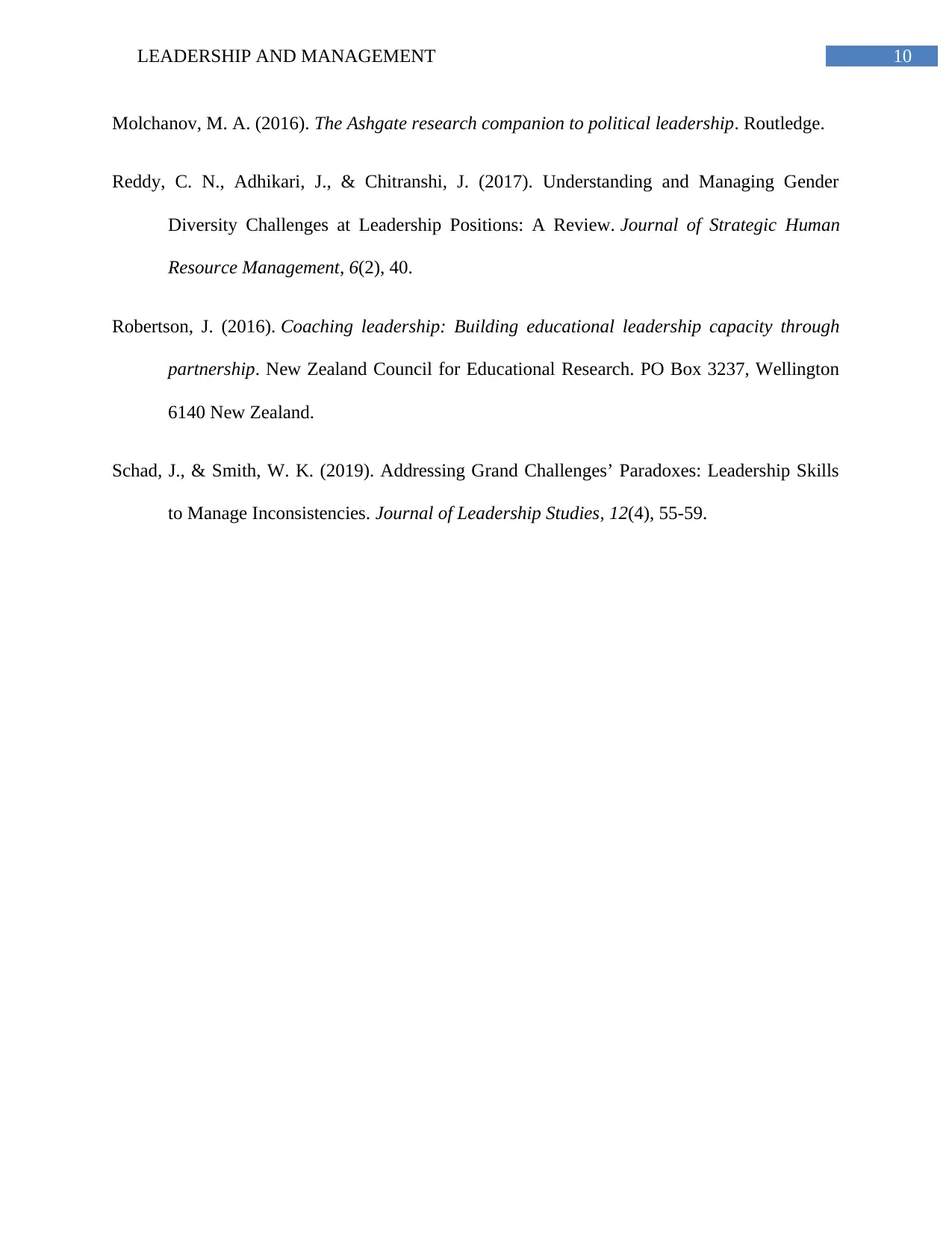
10LEADERSHIP AND MANAGEMENT
Molchanov, M. A. (2016). The Ashgate research companion to political leadership. Routledge.
Reddy, C. N., Adhikari, J., & Chitranshi, J. (2017). Understanding and Managing Gender
Diversity Challenges at Leadership Positions: A Review. Journal of Strategic Human
Resource Management, 6(2), 40.
Robertson, J. (2016). Coaching leadership: Building educational leadership capacity through
partnership. New Zealand Council for Educational Research. PO Box 3237, Wellington
6140 New Zealand.
Schad, J., & Smith, W. K. (2019). Addressing Grand Challenges’ Paradoxes: Leadership Skills
to Manage Inconsistencies. Journal of Leadership Studies, 12(4), 55-59.
Molchanov, M. A. (2016). The Ashgate research companion to political leadership. Routledge.
Reddy, C. N., Adhikari, J., & Chitranshi, J. (2017). Understanding and Managing Gender
Diversity Challenges at Leadership Positions: A Review. Journal of Strategic Human
Resource Management, 6(2), 40.
Robertson, J. (2016). Coaching leadership: Building educational leadership capacity through
partnership. New Zealand Council for Educational Research. PO Box 3237, Wellington
6140 New Zealand.
Schad, J., & Smith, W. K. (2019). Addressing Grand Challenges’ Paradoxes: Leadership Skills
to Manage Inconsistencies. Journal of Leadership Studies, 12(4), 55-59.
1 out of 11
Related Documents
Your All-in-One AI-Powered Toolkit for Academic Success.
+13062052269
info@desklib.com
Available 24*7 on WhatsApp / Email
![[object Object]](/_next/static/media/star-bottom.7253800d.svg)
Unlock your academic potential
Copyright © 2020–2025 A2Z Services. All Rights Reserved. Developed and managed by ZUCOL.





